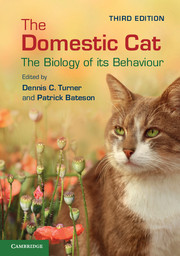Book contents
- Frontmatter
- Contents
- Contributors
- Abbreviations
- I Introduction
- II From Kitten- to Adulthood
- 2 Behavioural development in the cat
- 3 Normal and problematic reproductive behaviour in the domestic cat
- 4 Communication in the domestic cat: within- and between-species
- III Social Life and Ecology
- IV Cats and People
- V Cat Breeding and Cat Welfare
- VI The Future
- References
- Index
4 - Communication in the domestic cat: within- and between-species
Published online by Cambridge University Press: 05 December 2013
- Frontmatter
- Contents
- Contributors
- Abbreviations
- I Introduction
- II From Kitten- to Adulthood
- 2 Behavioural development in the cat
- 3 Normal and problematic reproductive behaviour in the domestic cat
- 4 Communication in the domestic cat: within- and between-species
- III Social Life and Ecology
- IV Cats and People
- V Cat Breeding and Cat Welfare
- VI The Future
- References
- Index
Summary
Introduction
Many previous accounts of communication between domestic cats have been largely based on a traditional ethological approach. The signals and the context in which they occur have been described and related to the kind of environment signaller and receiver can expect to find themselves in, and to the sensory capabilities of the receiver. For example, this approach explains the use of scent signals by domestic cats as products of both their acute sense of smell, which probably evolved primarily in relation to detection of food, and also their origin as territorial animals which needed to communicate with neighbours that they might rarely encounter face to face. However, the domestic cat is the product of two distinctly different phases of evolution, the first as a wild, largely solitary, predator, and the second as a commensal and then semi-domesticated social species, living in an increasingly dependent relationship with humans. There are few studies of the communicative repertoire of the ancestral species, Felis silvestris libyca, and it is now clear from the distribution of libyca DNA that many wild cats, including those from Africa and the Middle East, are, in varying proportions, hybrids between wild F. silvestris subspecies and domesticated F. s. catus (Driscoll et al., 2007). Commensalism will have brought with it new selection pressures on communication, largely intraspecific and resulting from the higher density at which these cats live, by comparison with that of their solitary ancestors.
- Type
- Chapter
- Information
- The Domestic CatThe Biology of its Behaviour, pp. 37 - 60Publisher: Cambridge University PressPrint publication year: 2013
- 3
- Cited by



